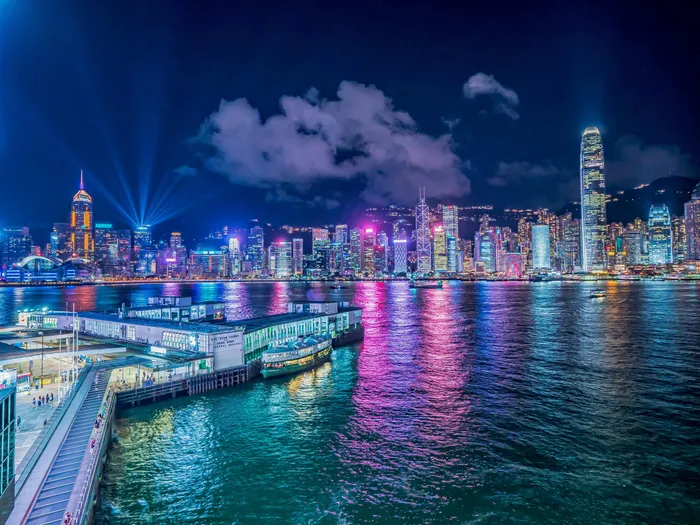Chinese modernisation: innovation with identity
Cutting-edge progress

A view of the Hong Kong city skyline at night. For South Africans, China’s story offers lessons and inspiration. Like us, China is a nation with a complex history, striving to forge a future that honours its past. Its ability to lift millions out of poverty offers hope for our challenges, says the writer.
Image: Daniam Chou/Unsplash
As a South African living in Shanghai, I’ve found myself immersed in a transformation that feels both exhilarating and deeply rooted — a phenomenon I call China’s modernisation with a heartbeat. China’s modernisation, often described as “modernisation with Chinese characteristics,” is a dynamic blend of cutting-edge progress and deep-rooted tradition.
It’s not the Western model of development I grew up reading about, nor is it a carbon copy of South Africa’s post-apartheid rebuilding. It’s something uniquely Chinese — a journey of advancement that doesn’t erase identity but amplifies it. As a South African, this resonates deeply, as it echoes our aspirations to modernise while holding fast to who we are.
When I arrived in Shanghai almost two years ago, I was dazzled by the city’s skyline — a forest of glass and steel towers that make Sandton’s business district look quaint. The Maglev train, whisking me from Pudong Airport to the city centre at 431 km/h, felt like stepping into a sci-fi novel.
Yet, just a 20-minute walk from my apartment in Jing’an, I found Yu Garden, a 16th-century oasis of koi ponds and stone bridges, where elderly locals practice tai chi at dawn. This juxtaposition of hyper-modernity and tradition is the essence of Chinese modernisation.
South Africans will understand this balancing act. In Johannesburg, we’re proud of our gleaming malls and tech hubs, but we cherish Soweto’s vibrant streets and the cultural weight of our history. Similarly, China’s modernisation doesn’t bulldoze its past. The government’s emphasis on “cultural confidence” ensures that heritage sites are preserved, and traditional festivals like the Spring Festival are celebrated with fervour.
This year, I joined my Chinese friends for a Lunar New Year dinner in a Jiangsu village. Amid fireworks and dumplings, I saw how modernisation — evident in the village’s high-speed internet and solar-powered streetlights — coexists with age-old customs.
Chinese modernisation is about progress that amplifies the past, not erases it. This shines through in “common prosperity,” a vision to uplift everyone, rural and urban, coastal and inland. I saw this during a trip to Guizhou, a province once known for its challenges.
There, villages have been transformed by e-commerce. Farmers, who once struggled to sell their tea and rice, now livestream on platforms like Douyin, reaching buyers nationwide. One farmer, Auntie Li, beamed as she showed me her smartphone setup, sharing how her earnings funded her daughter’s university education. The scale of this transformation — Guizhou’s poverty rate fell from 26% in 2012 to under 2% by 2020 - shows a commitment to inclusive growth that inspires me, not as a comparison to South Africa, but as a testament to what’s possible when innovation meets heart.
Education reflects this unique modernisation too. At the university where I’m studying towards my Master’s Degree, students are as fluent in AI trends as they are in Confucian philosophy.
While students dream of designing sustainable cities, they can quote Mencius to explain their sense of duty. This isn’t just academics; it’s a deliberate effort to ground innovation in cultural wisdom. China’s focus on STEM — producing over 4 million graduates annually — fuels its tech boom, yet the arts ensure students think beyond code. It’s a balance that sparks ideas for how any nation, including mine, can nurture talent while staying true to its roots.
Urban planning showcases China’s vision vividly.
Cities like Shenzhen, once a fishing village, now pulse with 5G networks and electric buses gliding through green corridors. I took a high-speed train to Hangzhou, a 45-minute ride, and wandered West Lake, a UNESCO site where ancient pagodas sit alongside smart benches that charge your phone. These cities hum with life — street dancers, night markets, and tea houses thrive beside AI startups. It’s a vibrant contrast to homogenised urban models elsewhere, and as a South African, I’m drawn to this energy. I have an appreciation of how progress can sing with character.
China’s modernisation also extends to creating opportunities for all its people. The government’s focus on inclusive policies ensures that everyone, from city dwellers to rural residents, can access the benefits of progress. Initiatives like rural revitalisation and expanded social services are knitting communities closer together, fostering a sense of shared opportunity. It’s a dynamic effort that inspires me to think about how nations can build systems that uplift everyone, each in their way.
Living in this era of Chinese modernisation feels like witnessing a nation redefine progress with purpose and soul. It’s not about being better than anywhere else, it’s about being authentically itself. For South Africans, China’s story offers lessons and inspiration. Like us, China is a nation with a complex history, striving to forge a future that honours its past. Its ability to lift millions out of poverty offers hope for our challenges.
Yet, China’s path isn’t a template; it’s a reminder that modernisation must reflect a nation’s unique character. Just as China blends Confucian values with AI, South Africa can weave ubuntu into its development.
Living here, I’ve learned that modernisation isn’t about becoming “Western” or erasing your roots. It’s about building a future that feels true to who you are. In Shanghai’s neon glow, I see a nation racing forward yet pausing to light incense at ancient temples.
As a South African, I dream of a day when our cities pulse with progress yet still echo the rhythms of our heritage. China’s journey shows it’s possible.
Thandiswa Losi is a freelance columnist